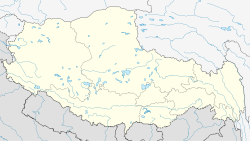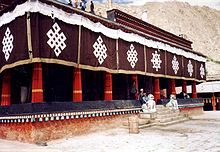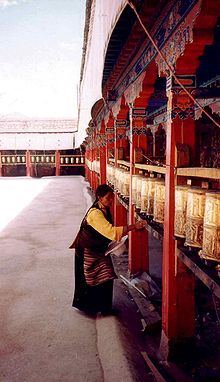- Nechung
-
Naiqung Monastery Tibetan name Tibetan གནས་ཆུང་དགོན། Wylie transliteration gnas-chung lcog Chinese name traditional 乃琼寺 Coordinates: 29°40′17″N 91°3′21″E / 29.67139°N 91.05583°E Monastery information Location Naiqung Town, Doilungdêqên Zong, Lhasa City, Tibet, China Type Tibetan Buddhist Sect Gelug Lineage Seat of the State Oracle of Tibet. Part of a series on Tibetan Buddhism
History Timeline · Related-topics Schools Nyingma · Kagyu · Sakya · Gelug · Bön · Jonang Key concepts Three marks of existence · Skandha · Cosmology · Saṃsāra · Rebirth · Bodhisattva · Dharma · Dependent origination · Karma Major figures Gautama Buddha · Padmasambhava · Je Tsongkhapa · Dalai Lama · Panchen Lama · Lama · Karmapa Lama · Rinpoche · Geshe · Terton · Tulku Buddhahood · Avalokiteśvara · Four stages of enlightenment · Tantric yoga · Paramitas · Meditation · Laity Changzhug · Drepung · Dzogchen · Ganden · Jokhang · Kumbum · Labrang · Mindroling · Namgyal · Narthang · Nechung · Pabonka · Palcho · Ralung · Ramoche · Sakya · Sanga · Sera · Shalu · Tashilhunpo · Tsurphu · Yerpa Chotrul Duchen · Dajyur · Losar · Monlam · Sho Dun Texts Kangyur · Tengyur · Tibetan canon · Mahayana sutras · Nyingma Gyubum Sand mandala · Thangka · Ashtamangala · Tree of physiology Outline · Comparative studies · Culture · List of topics · Portal
Naiqung Monastery, Naiqung Jog (Tibetan: གནས་ཆུང་དགོན།; ZYPY: Naiqung Jog "the small dwelling", Chinese: 乃琼寺), or Naiqung Goinba (Tibetan: གནས་ཆུང་དགོན་པ།; ZYPY: Naiqung Gönba), is the seat of the State Oracle of Tibet.
It is also referred to as Sungi Gyelpoi Tsenkar, the "Demon Fortress of the Oracle King."[1]
It is about 10 minutes walk down from Drepung Monastery, and was the residence of the three-headed, six-armed Pehar, the chief protector of the Gelugs (Yellow Hat sect) and the seat of the State Oracle or Nechung Oracle.[2] It is medium-sized temple which used to house about a hundred monks.[3]
Contents
History and functions
It was the seat of State Oracle until 1959 when he fled with the Dalai Lama to India who now lives in exile in Dharamsala, India. The Dalai Lamas traditionally always consulted him before making an important decision.[4]
It was the residence of the Protector Pehar, a deity of the Horpas, who lived to the east of (Lake) Kokonor. According to tradition, he is held to have been originally brought to Samye Monastery by Padmasambhava who bound him to protect the dharma.[5] An alternative story is that he was brought back by a Bon general, Tara Lugong, who took possession of the meditation school near Kanchow of the Bhaţa Hor, a tribe of Uighurs, about the end of the 8th century CE. Pehar was regarded as the guardian deity of the treasures of Samye Monastery and, later, as the 'protector of religion'.[6]
During the time of Lobsang Gyatso, the Fifth Dalai Lama (r. 1642-1682), Pehar was first moved from Samye to Tse Gugtang and then to the present site of Nechung Monastery.[7]
Although the State Oracle is a Nyingma monk, he has been adopted by the Gelugpas and is now chosen for his receptivity to possession by Pehar during trance.[8] He is considered to be the medium of Dorje Drakden, one of Pehar's aspects.[9]
When the State Oracle is possessed by Pehar, he becomes very agitated, with tongue lolling, bloodshot eyes and displays superhuman strength, lifting heavy weights, twisting swords, etc. He mumbles words which are recorded and then interpreted by monks and also blesses grain which is thrown to the crowd.[10][11]
Unlike most Central Asian shamans, who are thought to leave their bodies when in a trance-like state and travel to the land of the spirits from where they bring back messages, Tibetan oracles act "as a mouthpiece for the gods or spirits who possess him and speak through him, very often without his own knowledge of what is being said, answering directly the questions of those who consult him." The tradition of oracles was inherited from the pre-Buddhist religion of Tibet, Bön. The "great" Fifth Dalai Lama was "the first to institutionalise the State Oracle of Nächung."[12]
Nechung was almost completely destroyed during the Cultural Revolution and annexation of Tibet by China, though now, it has been largely restored and there is a huge new statue of Guru Rinpoche (Padmasambhava) on the second floor.[13] There is a college of debate to the east of Nechung which is once again attended by young students.
A new Nechung Monastery has been built in Dharamsala, India.[14]
-
Throne awaiting Dalai Lama's return. Retreat of the 13th Dalai Lama, Nechung, Tibet.
Footnotes
- ^ Dowman (1988), pp. 66-67.
- ^ Mayhew and Kohn (2005), p. 22.
- ^ Chapman (1940), p. 201.
- ^ Prince Peter (1979), pp. 51-56.
- ^ Dowman (1988), p. 67.
- ^ Stein (1972), pp. 68, 189.
- ^ Dowman (1988), p. 67.
- ^ Dowman (1988), p. 67.
- ^ Mayhew and Kohn (2005), p. 22.
- ^ Stein (1972), pp. 187-188.
- ^ Chapman (1940), p. 317.
- ^ Prince Peter (1979), p. 52.
- ^ Mayhew and Kohn (2005), p. 22.
- ^ Osada et al (2000), p. 83.
References
- Chapman, F. Spencer. (1940) Lhasa: The Holy City. Readers Union Ltd., London.
- Dowman, Keith (1988). The Power-places of Central Tibet: The Pilgrim's Guide. Routledge & Kegan Paul, London. ISBN 0-7102-1370-0.
- Mayhew, Bradley and Kohn, Michael. Tibet. (2005). Lonely Planet Publications. ISBN1-74059-523-8.
- (H.R.H. Prince) Peter of Greece and Denmark. (1979). "Tibetan Oracles." The Tibet Journal, Vo. 4, No. 2, Summer 1979, pp. 51-56.
- Osada et al (2000). Mapping the Tibetan World. Yukiyasu Osada, Gavin Allwright, and Atsushi Kanamaru. Reprint: 2004. Kotan Publishing, Tokyo. ISBN 0-9701716-0-9.
- Stein, R. A. (1972). Tibetan Civilization. Stanford University Press.
External links
- Nechung the State Oracle of Tibet by David Cherniack
Lhünzhub · Damxung · Nyêmo · Qüxü · Doilungdêqên · Dagzê · Maizhokunggar · Chengguan District
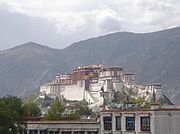
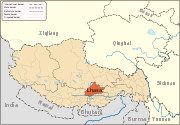
Towns and villages Monasteries
and palacesArchitecture of Lhasa · Lingkhor · Potala Palace · Norbulingka · Jokhang Temple · Tsomon Ling · Ganden Monastery · · Kundeling Monastery · Nechung · Nyethang Drolma Lhakhang Temple · Yangpachen Monastery · · Drepung Monastery · Ramoche Temple · Reting Monastery · Sanga Monastery · Yerpa
Sera Monastery: · Chupzang Nunnery · Drakri Hermitage · Garu Nunnery · Jokpo Hermitage · Keutsang Hermitage · Keutsang East Hermitage · Keutsang West Hermitage · Khardo Hermitage · Negodong Nunnery · Nenang Nunnery · Pabongkha Hermitage · Panglung Hermitage · Purbuchok Hermitage · Rakhadrak Hermitage · Sera Chöding Hermitage · Sera Gönpasar Hermitage · Sera Utsé Hermitage · Takten Hermitage · Trashi Chöling HermitageOther landmarks Banak Shöl Hotel · Barkhor · Chokpori · Drapchi Prison · Lhasa Brewery · Lhasa Hotel · Lhasa Zhol Pillar · Tibet Museum · Tibet University · Tromzikhang · Nyang bran · Hutoushan ReservoirTransport Lhasa Airport · Damxung Railway Station · Lhasa Railway Station · Lhasa West Railway Station · Wumatang railway station · Yangbajain Railway Station · G109 · G318 · North Linkor RoadGovernment Doje Cezhug · Jigme Namgyal
Buddhist monasteries in Tibet Lhasa Prefecture Ani Tsankhung Nunnery · Drepung Monastery · Drigung Monastery · Ganden Monastery · Jokhang · Kundeling Monastery · Muru Nyingba Monastery · Namgyal Monastery · Nechung · Nyethang Drolma Lhakhang Temple · Ramoche Temple · Reting Monastery · Sanga Monastery · Taklung Yarthang Monastery · Tradruk Temple · Tsomon Ling · Tsurphu Monastery · Yangpachen Monastery · Yerpa · Zhuowaqudeng Monastery
Sera Monastery: · Chupzang Nunnery · Drakri Hermitage · Garu Nunnery · Jokpo Hermitage · Keutsang Hermitage · Keutsang East Hermitage · Keutsang West Hermitage · Khardo Hermitage · Negodong Nunnery · Nenang Nunnery · Pabongkha Hermitage · Panglung Hermitage · Purbuchok Hermitage · Rakhadrak Hermitage · Sera Chöding Hermitage · Sera Gönpasar Hermitage · Sera Utsé Hermitage · Takten Hermitage · Trashi Chöling HermitageShannan Prefecture Shigatse Prefecture Changmoche Monastery · Lhatse · Chokorgyel Monastery · Daklha Gampo · Dorje Pakmo · Drongtse Monastery · Donggar Monastery · Garju Monastery · Manmogang Monastery · Menri Monastery · Milarepa's Cave · Narthang Monastery · Ngor · Palcho Monastery · Ralung Monastery · Samding Monastery · Sakya Monastery · Ṣalu Monastery · Shelkar · Tashilhunpo · Tsi Nesar · Tsechen Monastery and DzongNgari Prefecture Chamdo Prefecture
and former KhamGalden Jampaling Monastery · Karma Gon Monastery · Benchen Monastery · Dorje Drak · Dzogchen Monastery · Dzongshar Monastery · Kandze Monastery · Katok Monastery · Nanwu Si Monastery · Palyul · Riwoche Monastery · Shechen Monastery · Surmang · Tongkor ·Nyingchi Prefecture
Wikimedia Foundation. 2010.


